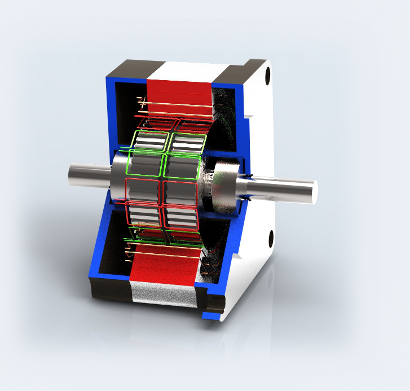Servo Motion Actuator Replaces Encoder With Position Sensor
August 12, 2015

For engineers seeking a motor scaled down in size but not power, QuickSilver Controls has extended its Mosolver (portmanteau of “motor” and “resolver”) servo motion actuator into a NEMA 17 frame format. The follow-up to its NEMA 23 Mosolver, the goal was to meet the needs of companies operating space-sensitive equipment.
The solution adds a position feedback sensor into the structure of a high pole count AC motor, eliminating the need for an encoder and resolvers. In a tight environment, the use of an encoder is often difficult, if not impossible, and today’s thin, compact encoders can be cost-prohibitive and require weeks or months of lead time to source.

The Mosolver actuator combines the motor and resolver into a single package while providing 32,000 counts of position information using a compact nylon sensor coil placed within the stator opposite the rotor. The result is compact, inexpensive, and robust closed-loop motion control with good torque.
Don Labriola, president of QuickSilver Controls, out of San Dimas, Calif., told Design News that the primary advantages of removing the encoder is a reduction in size, as well as cost.
“With the encoder size not that much smaller for a (NEMA) 17 frame than a 23 frame, the overall size reduction, as a percentage, is better as the motor size goes down,” he said. “The cost of an encoder added to a motor is just part of it. You still need to assemble and align the resulting system. In a harsh environment, you also need to protect the encoder, which drives up costs.”
MORE FROM DESIGN NEWS: The Growing Need to Solve Light-Load Motor Efficiency
The Mosolver adds a flex circuit to the interior of the motor at assembly time. “The materials are significantly less than for an encoder, there’s no alignment, and there are no additional housings needed to protect the device,” Labriola said.
He noted that compared to the motor, the encoder is usually frailer and becomes more so as it’s scaled down to smaller sizes. It’s also prone to overheating and accumulating grease or dust on the encoder disk. By getting rid of the most sensitive component and putting the Mosolver into a smaller package, Quicksilver is looking to expanded market applications. The company has received custom configuration inquiries.
“We recently received a query for use in a radiation environment,” Labriola told Design News. “The customer is trying to use encoder disks, and radiation exposure is causing the disks to darken, which is causing problems. In the Mosolver, everything is passive -- there’s no electronics to be affected by radiation -- and the polyamide itself is a highly-rated radiation-resistant material.”
The company believes that a NEMA 17 frame will be particularly attractive to medical and scientific laboratory environments that are operating small positioning stations. Labs are often expensive to operate, and most hospitals cannot make nearly as much per square foot of lab as they do with hospital beds. Equipment for new tests needs to be added regularly, but lab sizes remain static.
MORE FROM DESIGN NEWS: MicroE, Applimotion Merger Will Ramp Motion Control Customization
“Size is always a major factor in labs, and keeping it small helps,” Labriola said. “Running separate motors and keeping them cool takes up a lot more space. If you can keep from making heat in the first place, you don’t have to add refrigeration.”
Labriola said the company is seeking to expand the technology into larger formats in both frame size and torque, which could lead to exercise machine applications. Without an encoder, manufacturers would be free to use a larger motor in a smaller footprint.
“The alignment is inherent, because it’s using the same magnetic field to run the motor, and you’re automatically aligned,” Labriola said. “In terms of basic reliability, there are fewer items in the motor, and you’re already inside a magnetic field.”
QuickSilver is also working on research and development to put its Mosolver technology into a submersible IP68 package, which would open up a number of pumping and dredging applications.

We’re heading to Philly! Design & Manufacturing Philadelphia will take place Oct. 7-8. Get up close with the latest design and manufacturing technologies, meet qualified suppliers for your applications, and expand your network. Learn from experts at educational conferences and specialty events. Register today and join us at Philadelphia’s premier industry showcase!
Tracey Schelmetic graduated from Fairfield University in Fairfield, Conn. and began her long career as a technology and science writer and editor at Appleton & Lange, the now-defunct medical publishing arm of Simon & Schuster. Later, as the editorial director of telecom trade journal Customer Interaction Solutions (today Customer magazine) she became a well-recognized voice in the contact center industry. Today, she is a freelance writer specializing in manufacturing and technology, telecommunications, and enterprise software.
About the Author(s)
You May Also Like
.jpg?width=300&auto=webp&quality=80&disable=upscale)


